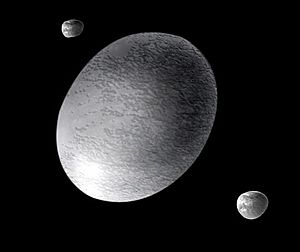Haumea (dwarf planet) facts for kids

Haumea is a dwarf planet found in our Solar System. Scientists Michael E. Brown, Chad Trujillo, and David Rabinowitz from the United States, along with J. L. Ortiz from Spain, announced its discovery in 2005. It was officially named a dwarf planet on September 17, 2008.
Haumea is known as a Trans-Neptunian object because it orbits the Sun far beyond Neptune. It has two known moons, named Hiʻiaka and Namaka. Haumea is special because it spins very fast and has an unusual shape. It completes one full turn on its axis every four hours. This quick spin makes Haumea look like a squashed ball, also called an ellipsoid. It was the fifth dwarf planet ever discovered.
Naming the Dwarf Planet
The object was first nicknamed 'Santa' because it was found right after Christmas. In 2008, the International Astronomical Union gave it the official name Haumea. This name comes from a Hawaiian god of childbirth and new life.
Haumea's Ring System
On January 21, 2017, scientists watched Haumea pass in front of a star. This event, called a stellar occultation, helped them discover something amazing: Haumea has a ring around it! This was the first time a ring system was found around a Trans-Neptunian object.
The ring is about 2,287 kilometers away from Haumea's center. It is about 70 kilometers wide. The ring is also tilted a little bit, similar to the path of its larger moon, Hiʻiaka.
| The Solar System | |||||||
|---|---|---|---|---|---|---|---|
|
|
|||||||
| Sun • Heliosphere |
Planets ☾ = moon(s) ∅ = rings |
Mercury | Venus | Earth ☾ | Mars ☾ | ||
| Jupiter ☾ ∅ | Saturn ☾ ∅ | Uranus ☾ ∅ | Neptune ☾ ∅ | ||||
| Dwarf planets | Ceres | Pluto ☾ | Haumea ☾ | Makemake | |||
| Eris ☾ | |||||||
| Small Solar System bodies |
Asteroids (minor planets) |
Groups and families: Vulcanoids · Near-Earth asteroids · Asteroid belt Jupiter Trojans · Centaurs · Neptune Trojans · Asteroid moons · Meteoroids · Pallas · Juno · Vesta · Hygiea · Interamnia · Europa |
|||||
| See also the list of asteroids. | |||||||
| Trans- Neptunians |
Kuiper belt – Plutinos: Orcus · Ixion – Cubewanos: Varuna · Quaoar · Huya |
||||||
| Scattered disc: Sedna | |||||||
| Comets | Periodic comets and non-periodic comets Damocloids · Oort cloud |
||||||
| See also the list of solar system objects | |||||||
Images for kids
-
Haumea's orbit outside of Neptune is similar to Makemake's. The positions are as of 1 January 2018.
-
Haumea and its orbiting moons, imaged by Hubble in 2008. Hiʻiaka is the brighter, outermost moon, while Namaka is the fainter, inner moon.
-
Haumea imaged by the New Horizons spacecraft in October 2007
See also
 In Spanish: Haumea (planeta enano) para niños
In Spanish: Haumea (planeta enano) para niños






